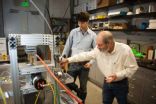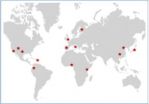(Press-News.org) Berkeley — The more time it takes for an earthquake fault to heal, the faster the shake it will produce when it finally ruptures, according to a new study by engineers at the University of California, Berkeley, who conducted their work using a tabletop model of a quake fault.
"The high frequency waves of an earthquake — the kind that produces the rapid jolts — are not well understood because they are more difficult to measure and more difficult to model," said study lead author Gregory McLaskey, a former UC Berkeley Ph.D. student in civil and environmental engineering. "But those high frequency waves are what matter most when it comes to bringing down buildings, roads and bridges, so it's important for us to understand them."
While the study, to be published in the Nov. 1 issue of the journal Nature and funded by the National Science Foundation, does nothing to bring scientists closer to predicting when the next big one will hit, the findings could help engineers better assess the vulnerabilities of buildings, bridges and other structures when a fault does rupture.
"The experiment in our lab allows us to consider how long a fault has healed and more accurately predict the type of shaking that would occur when it ruptures," said Steven Glaser, UC Berkeley professor of civil and environmental engineering and principal investigator of the study. "That's important in improving building designs and developing plans to mitigate for possible damage."
To create a fault model, the researchers placed a Plexiglas slider block against a larger base plate and equipped the system with sensors. The design allowed the researchers to isolate the physical and mechanical factors, such as friction, that influence how the ground will shake when a fault ruptures.
It would be impossible to do such a detailed study on faults that lie several miles below the surface of the ground, the authors said. And current instruments are generally unable to accurately measure waves at frequencies higher than approximately 100 Hertz because they get absorbed by the earth.
"There are many people studying the properties of friction in the lab, and there are many others studying the ground motion of earthquakes in the field by measuring the waves generated when a fault ruptures," said McLaskey. "What this study does for the first time is link those two phenomena. It's the first clear comparison between real earthquakes and lab quakes."
Noting that fault surfaces are not smooth, the researchers roughened the surface of the Plexiglas used in the lab's model.
"It's like putting two mountain ranges together, and only the tallest peaks are touching," said McLaskey, who is now a postdoctoral researcher with the U.S. Geological Survey in Menlo Park.
As the sides "heal" and press together, the researchers found that individual contact points slip and transfer the resulting energy to other contact points.
"As the pressing continues and more contacts slip, the stress is transferred to other contact points in a chain reaction until even the strongest contacts fail, releasing the stored energy as an earthquake," said Glaser. "The longer the fault healed before rupture, the more rapidly the surface vibrated."
"It is elegant work," said seismologist John Vidale, a professor at the University of Washington who was not associated with the study. "The point that more healed faults can be more destructive is dismaying. It may not be enough to locate faults to assess danger, but rather knowing their history, which is often unknowable, that is key to fully assessing their threat."
Glaser and McLaskey teamed up with Amanda Thomas, a UC Berkeley graduate student in earth and planetary sciences, and Robert Nadeau, a research scientist at the Berkeley Seismological Laboratory, to confirm that their lab scenarios played out in the field. The researchers used records of repeating earthquakes along the San Andreas fault that Nadeau developed and maintained. The data were from Parkfield, Calif., an area which has experienced a series of magnitude 6.0 earthquakes two to three decades apart over the past 150 years.
Thomas and McLaskey explored the records of very small, otherwise identically repeating earthquakes at Parkfield to show that the quakes produced shaking patterns that changed depending on the time span since the last event, just as predicted by the lab experiments.
In the years after a magnitude 6.0 earthquake hit Parkfield in 2004, the small repeating earthquakes recurred more frequently on the same fault patches.
"Immediately after the 2004 Parkfield earthquake, many nearby earthquakes that normally recurred months or years apart instead repeated once every few days before decaying back to their normal rates," said Thomas. "Measurements of the ground motion generated from each of the small earthquakes confirmed that the shaking is faster when the time from the last rupture increases. This provided an excellent opportunity to verify that ground motions observed on natural faults are similar to those observed in the laboratory, suggesting that a common underlying mechanism — fault healing — may be responsible for both."
Understanding how forcefully the ground will move when an earthquake hits has been one of the biggest challenges in earthquake science.
"What makes this study special is the combination of lab work and observations in the field," added Roland Burgmann, a UC Berkeley professor of earth and planetary sciences who reviewed the study but did not participate in the research. "This study tells us something fundamental about how earthquake faults evolve. And the study suggests that, in fact, the lab setting is able to capture some of those processes correctly."
Glaser said the next steps in his lab involve measuring the seismic energy that comes from the movement of the individual contact points in the model fault to more precisely map the distribution of stress and how it changes in the run-up to a laboratory earthquake event.
INFORMATION:
Tabletop fault model reveals why some quakes result in faster shaking
2012-11-01
ELSE PRESS RELEASES FROM THIS DATE:
Unexpected factor contributes to melanoma risk in red-haired, fair-skinned individuals
2012-11-01
The well-established elevated risk of melanoma among people with red hair and fair skin may be caused by more than just a lack of natural protection against ultraviolet (UV) radiation. In an article receiving Advance Online Publication in Nature, Massachusetts General Hospital (MGH) Cutaneous Biology Research Center (CBRC)and Cancer Center researchers report finding that the type of skin pigment predominantly found in red-haired, fair-skinned individuals may itself contribute to the development of melanoma.
"We've known for a long time that people with red hair and ...
Pond skating insects reveal water-walking secrets
2012-11-01
This month's special issue of Physics World is devoted to animal physics, and includes science writer Stephen Ornes explanation of how pond skaters effortlessly skip across water leaving nothing but a small ripple in their wake.
As Ornes writes, our current understanding of the mechanisms adopted by the pond skater is down to the efforts of David Hu, who as a mathematics graduate from the Massachusetts Institute of Technology spent four years studying their behaviour.
Hu, along with his PhD supervisor John Bush, found that pond skaters use the middle of their three ...
Sleep duration affects hunger differently in men and women
2012-11-01
A new study suggests that increasing the amount of sleep that adults get could lead to reduced food intake, but the hormonal process differs between men and women.
"Restricting sleep in healthy, normal weight participants has limited effects on metabolic risk factors and may affect food intake regulating hormones differently in men and women," said Marie-Pierre St-Onge, PhD, FAHA, the study's principal investigator. "We were surprised by the lack of a significant effect of sleep on glucose and insulin, leptin, and sex differences in the hunger-stimulating hormone ghrelin ...
Scientific team sequences 1,092 human genomes to determine standard range of human genetic variation
2012-11-01
Completing the second phase of the 1000 Genomes Project, a multinational team of scientists reports that they have sampled a total of 1092 individuals from 14 different populations and sequenced their full genomes. The researchers described the feat as a collegial effort to equip biologists and physicians with information that can be used to understand the normal range of human genetic variants so that a patient's disease genome can be interpreted in a broader context.
A report on the research, published online in Nature on Nov. 1 represents the culmination of five years ...
1,000 Genomes Project paints detailed picture of human variation
2012-11-01
HOUSTON -- (Nov. 1, 2012) – First, there was the single human reference genome completed in 2003. Then there was the HapMap project to identify the common genetic variants occurring in human beings with the first map published in 2005. Now an international consortium has released the first phase of the 1,000 Genomes Project that profiles the rare and common genetic variations in 1,092 people drawn from 14 human populations from Europe, Africa, East Asia and the Americas.
The next phase of the project will include as many as 3,000 individuals, said Dr. Fuli Yu (www.bcm.edu/genetics/index.cfm?pmid=23673
), ...
New genetic links for inflammatory bowel disease uncovered
2012-11-01
Crohn's disease (CD) and ulcerative colitis (UC) – inflammatory diseases of the gastrointestinal tract – have puzzled the scientific community for decades. Ten years ago, researchers recognized that both genes and the environment contributed to these diseases but knew little about precisely how and why illness occurred. To begin to narrow in on the key pathways involved, they would need thousands of patients' samples, millions of data points, and the commitment of physicians and scientists at dozens of institutions.
Today, researchers from across the CD and UC communities ...
Fear of math can hurt
2012-11-01
Fear of math can activate regions of the brain linked with the experience of physical pain and visceral threat detection, according to research published Oct 31 by Ian Lyons and colleagues at the University of Chicago in the open access journal PLOS ONE.
The researchers found that in individuals who experience high levels of anxiety when facing math tasks, the anticipation of math increases activity in regions of the brain associated with the physical sensation of pain. The higher an individual's math anxiety, the more such neural activity was increased.
According ...
5 year olds are generous only when they're watched
2012-11-01
Children as young as five are generous when others are aware of their actions, but antisocial when sharing with a recipient who can't see them, according to research published Oct. 31 in the open access journal PLOS ONE by Kristin Lyn Leimgruber and colleagues from Yale University.
Adults are more likely to behave in ways that enhance their reputation when they are being watched or their actions are likely to be made public than when they are anonymous, but this study examines the origins of such behavior in young children for the first time. For their study, the researchers ...
Desert farming forms bacterial communities that promote drought resistance
2012-11-01
When there is little water available for plants to grow, their roots form alliances with soil microbes that can promote plant growth even under water-limiting conditions, according to research published Oct. 31 by Daniele Daffonchio and colleagues from the University of Milan, Italy in the open access journal PLOS ONE.
Symbiotic relationships between plants and soil microbial communities are critical to the health of plants. Though the effects of drought on plants are well-known, little is known about how lack of water affects the bacteria around plant roots.
In this ...
Western aspen trees commonly carry extra set of chromosomes
2012-11-01
A large proportion of aspen in the western U.S. sport an extra set of chromosomes in their cells, a phenomenon termed triploidy, according to new research published Oct. 31 in the open access journal PLoS ONE by Karen Mock from Utah State University and colleagues at several other institutions. In some areas of southern Utah and Colorado, over 60% of aspen trees are triploid.
Though triploid trees are not uncommon, this genetic anomaly can cause altered physical traits including sterility or reduced fertility. Although a triploid aspen clone may reproduce with root ...


